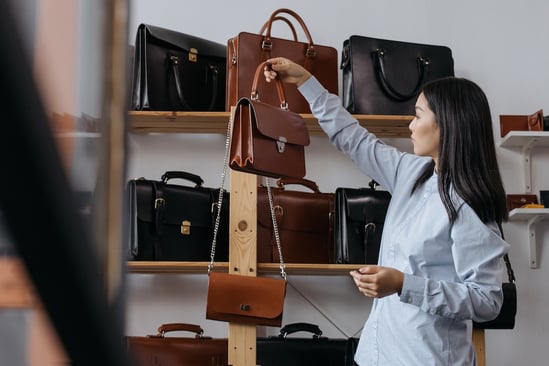
As the lines between our online and offline lives get blurrier, shopping behaviors are changing irrevocably. The omnichannel nature of modern retail has given rise to two related shopping trends: webrooming and showrooming.
Webrooming refers to researching a product online before buying it in a store. Showrooming is the opposite of webrooming — it’s when consumers browse products in a store but make their final purchases online. Below you’ll find both showrooming and webrooming examples.
Both of these trends highlight how fluid consumers’ shopping habits have become. And both need to be accommodated if brands and retailers want to keep pace with their competition.
Here are some pros, cons, and best practices for using showrooming and webrooming to your advantage.
What Is Webrooming?
Webrooming is when a consumer browses a product online but then makes their final purchase in a store. According to Salsify’s “2024 Consumer Research” report, a survey of thousands of shoppers in the U.S. and U.K., 63% of shoppers are guilty of webrooming.
There are a number of reasons why someone may shop like this. For example, if a consumer researching a product online sees that it’s available in a nearby store, they may go pick it up so they can get the product immediately without having to pay for shipping.
Webrooming gives people an opportunity to do most of their browsing from the comfort of their homes but still see and feel a product before purchasing.
Here’s a perfect webrooming example: Someone looking for new hiking boots wants to compare styles, features, and prices online, but they still think it’s important to try the shoes on before taking them on the trail if they want to guarantee a great fit.
What Is Showrooming?
Showrooming is when a consumer looks at products in a store but makes their final purchase online. Forty-eight percent of shoppers admitted to showrooming in Salsify’s survey.
It’s become common practice for consumers to browse online retailers even while standing inside a brick-and-mortar store. According to Salsify’s consumer research, 54% of shoppers have used a smartphone to learn more about a product while in a physical store, and 23% of shoppers have used a smartphone to buy a product while in a physical store.
Whether they’re using their phones in-store or going home to do additional online research, showrooming is a way for consumers to take control of their shopping experiences. They may want to read reviews, compare prices, or look up additional product information before having to make their final choices.
For example, someone shopping for a new lipstick may want to look at colors in person but compare online reviews for different brands before buying. A consumer browsing in a store may come across a sweater they want to own, but then price compare online so they can buy it on sale.
Some retailers are understandably frustrated by showrooming, as it can drive more sales to competitors. But the practice isn’t going anywhere — Shopify and Forrester also echoed that 54% of consumers are likely to look at a product in-store and later buy it online. Retailers need to adapt to this behavior instead of fighting it.
The Pros and Cons of Webrooming and Showrooming
Neither webrooming nor showrooming are inherently negative. Instead, each has a unique set of pros and cons. Like almost any new trend, they introduce challenges to retailers who can’t adapt and opportunities to those who can.
The Pros and Cons of Webrooming
Webrooming allows consumers to do thorough product research on their own time but still feel confident that they know exactly what they’re getting. Brands and retailers gain the opportunity to better serve consumers by offering the convenience of online shopping alongside the more personal experience of in-store service.
Pros of webrooming:
- Consumers save money on shipping costs.
- Consumers can enjoy the instant satisfaction of picking up the exact product they want.
- Getting online shoppers into a store gives your sales team opportunities to upsell.
Cons of webrooming:
- Your sales team may have fewer opportunities to engage with consumers if they’re not browsing in-store.
- If a consumer expects a product to be in a store and it isn’t, they’ll be frustrated.
The Pros and Cons of Showrooming
Showrooming may have a bad reputation for “stealing sales,” but showroomers don’t always buy from competitors. If you give them a great shopping experience both online and off, you’ll be able to retain them across channels.
Pros of showrooming:
- Consumers don’t have to feel limited by the stock available in-store.
- Retailers can have smaller physical footprints, thus saving on overhead costs.
- Consumers can enjoy a more relaxed, browsing-focused in-store experience instead of feeling pressured to make a decision.
Cons of showrooming:
- There is a chance of losing sales to online competitors.
- Sales associates have fewer opportunities to make final sales.
How Can Brands Adapt to Webrooming and Showrooming?
Webrooming and showrooming are two sides of the same coin, and both are indicative of how pervasive omnichannel commerce has become. To welcome shoppers of all kinds and cater to all preferences, consider the following practices.
Turn Your Retail Store Into a Showroom
Many brands have adapted to the rise in showrooming by turning their storefronts into something resembling a literal showroom. These smaller storefronts are designed to create memorable customer experiences and let them explore the offerings available to them without pressure to make final sales.
This is common among many newer brands that began online. For example, digital-first menswear brand Bonobos refers to its physical stores as “guideshops” because their primary purpose is to give consumers opportunities to interact with stylists, known as “guides.”
Make the In-Person Shopping Experience Memorable
While the above showroom approach may not be appropriate for every brand, there are many other ways to make the in-person shopping experience unique.
Better-trained salespeople, appointment shopping that guarantees personalized attention, and in-store events, among other strategies, can make your store a destination. This appeals to showroomers’ desire for a browsing-first experience while introducing the potential to keep webroomers in-store longer.
Offer In-Store Discounts
Online retailers often offer products at lower prices than can be found in stores. You can counter this by offering exclusive in-store sales, unique products, and proximity deals sent to shoppers’ smartphones.
Ensure That Your Inventory Management Is Always Accurate
Webroomers often check online to make sure a store has the product they want. If they drive to a store only to find that the product isn’t there after all, they’ll become understandably frustrated.
To satisfy today’s omnichannel shoppers, it’s important to invest in technology that guarantees that inventory is tracked consistently and accurately across all channels.
Provide In-Store Pickup and Ordering
Make life easy for both webroomers and showroomers by allowing consumers to pick up or place orders in your store.
If someone wants to order something online because your store doesn’t have the exact item they want, sales associates should be able to facilitate that order and have the product delivered to wherever it would be most convenient for the consumer.
Similarly, if a shopper wants to order something but doesn’t want to pay shipping, they should be able to opt to have it delivered to a nearby store for them to pick up.
These practices have become commonplace in recent years, and any retailer that doesn’t offer them will be viewed as outdated.
Catering to Modern Consumers Across All Channels
Every shopper has their own preferences. Increasingly, these preferences involve innovative approaches that blur the boundaries between physical and digital storefronts.
Consumers want to be able to shop wherever and however it’s convenient for them — whether online, in person, or a combination of both — and be consistently satisfied by their experiences.
By adapting to webrooming and showrooming trends and catering to both types of shoppers, you’ll be able to build winning shopping experiences for every consumer.

2024 Consumer Research
Discover how consumers move through the modern buying journey and the latest trends to help you stay ahead of the competition on the digital shelf.
DOWNLOAD REPORT
The Complete Guide to Winning Shopping Experiences
For more tips on building winning shopping experiences for today’s consumers, download our guide.
DOWNLOAD GUIDE
Tag(s):
Product Page Optimization
Written by: Nicole D'Angelo
Nicole D’Angelo (she/her) is a freelance writer, editor, and content marketer with over eight years of experience creating content for various industries. Previously, she managed content production for business-to-business (B2B) and business-to-consumer (B2C) brands, including Fortune 500 companies.
Recent Posts
Ecommerce Marketing
|
12 minute read
The Art of the Impulse Buy: 70% of Shoppers Say Discounts Drive Unplanned Purchases — Here’s Why
Read More
Ecommerce Marketing
|
10 minute read
What Does It Take To Have a Good Brand Reputation in 2025?
Read More
Ecommerce Trends
|
11 minute read
What Is Commerce Media — and How Can It Optimize Your Marketing Spend?
Read More
Subscribe to the Below the Fold Newsletter
Standing out on the digital shelf starts with access to the latest industry content. Subscribe to Below the Fold, our monthly content newsletter, and join other commerce leaders.
2024 Consumer Research
Discover how consumers move through the modern buying journey and the latest trends to help you stay ahead of the competition on the digital shelf.
DOWNLOAD REPORT

.svg)